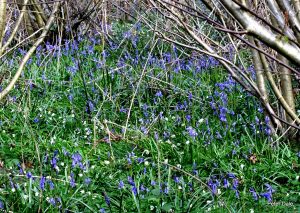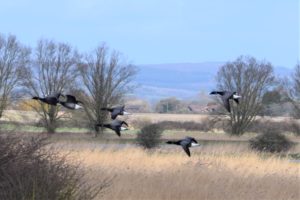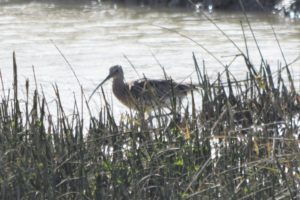If you have a nest box or any nest in your garden, this might be a good time to keep a regular watch and record dates of bringing in nesting materials, food, and removal of faecal sacs and later fledgling. When baby birds are being fed it is amazing to see how frequently the adults come to the nest. You can count how many times in say 10 minutes. If you know where the nest boxes are around the village you could also record activity there.
minutes. If you know where the nest boxes are around the village you could also record activity there.
Keep an eye on the sky. There are many reports of buzzards (over the Rife, from David Bettiss) and kites and a pair of buzzard are probably breeding again on the west side of the East Preston/Ferring gap.
Bird song is brilliant at the moment. Check you can identify the song of robin and blackbird. You can see them singing to confirm identity. Try to learn one song at a time. Small migrants are starting to arrive: listen out for the first of the warblers, the chiffchaff. This is the easiest song to identify because all they do is go ‘chiff’ and ‘chaff’, like a pendulum. Don’t confuse with a great tit which goes ‘teach-er, teach-er”.
Graham has reported butterflies in his garden: a comma, peacock and brimstone Brimstones are pale yellow, males brighter than females. I have seen small tortoiseshell and red admiral. Any records of small tortoiseshell would be useful.
Graham Tuppen has evidence of hedgehogs in his garden and he says that bluebells are just beginning to come out in Clapham Woods together with the lovely wood anemones.
Being somewhat confined, might be a good time to start doing some daily records of observations in your garden. You might be surprised at what turns up! A note book and identification books are all you need whilst sitting in the sun.
Monthly Archives: March 2020
Presentation to Chestnut Tree House Children’s Hospice
The Group’s Chairman David Bettiss, accompanied by Tricia Hall, recently visited the local Chestnut Tree House Children’s Hospice to present a cheque for £600 raised by the sale of Tricia’s beautifully designed  Christmas Cards. The cards have been sold on behalf of Ferring Conservation Group exclusively to raise funds for the Hospice. The Group are delighted to have supported Chestnut Tree House over the last 8 years with many thousands of pounds raised in this way.
Christmas Cards. The cards have been sold on behalf of Ferring Conservation Group exclusively to raise funds for the Hospice. The Group are delighted to have supported Chestnut Tree House over the last 8 years with many thousands of pounds raised in this way.
Cancellation of Members Meetings
Due to the ongoing Coronavirus situation, we are cancelling the next two members meetings in March and April. We’ll be reviewing the situation after that, and hope to be resuming the meetings once things have improved.
Group Visit to Pagham Harbour
A small group of members made their Spring visit to the North Wall at Pagham Harbour, ably led by our local birdwatching expert Clive Hope. It was a windy and pretty chilly day, but this didn’t seem to put off the birds. Luckily we managed to avoid the threatened showers, but the wet winter meant that the nearby fields were generally flooded. This though did seem to attract many birds in good numbers, with an excellent total of 37 different species seen. 
The highlights of the day were a large group of up to 16 Cattle Egrets which were showing well, alongside a healthy population of Grey Herons who were probably breeding in the nearby trees. It would be great if the Egrets follow suit and start breeding there. There were also in the region of 400 or so Black-Tailed Godwits – an impressive sight whenever they took to the air, something in the region of 40-50 Curlew with their haunting winter calls, and scores of Dark-Bellied Brent Geese flying overhead to the nearby fields when the tide was rising in the harbour.
Curlew with their haunting winter calls, and scores of Dark-Bellied Brent Geese flying overhead to the nearby fields when the tide was rising in the harbour.
All in all, it was a most enjoyable birdwatching visit to a wonderful location which is only about half an hour away from us, and was capped off with a visit to the nearby cafe in Pagham village for lunch before returning home.
The Wadars planning application
Please see below the information handout from Wadars relating to their recent planning application to develop their site to improve the animal wefare facilities there. It clearly outlines the benefits of the scheme and lays to rest the negative comments made by some. Ferring Conservation Group supports the application – the reference number is FG/6/20.
Wadars Rescue and Rehoming Centre, Ferring
Response to concerns raised on the planning portal.
Rewilding As a past livery yard, the property as it stands is almost entirely of concrete and therefore, encourages no natural wildlife beyond vermin and feral cats. We do attract swallows, which continue to nest in our permanent stables. Wadars specialises in the rescue and rehabilitation of wildlife. Our development plans support our work and include creating green spaces throughout the old stable yard, both natural meadow and landscaped, and increasing the number of trees. This is needed both for the improvement of the natural environment and for natural scent and sight barriers between species.
Building design & sustainability The only UPVC structures are those in the further development of the cattery. These are fully insulated units and provide the best possible environment for cats and kittens in a rescue environment. All other construction, including the kennels, are from robust traditional build materials, fully insulated, and include the use of photovoltaic panels for sustainable energy generation. Units are low impact and finished in brickwork and wood fibre cladding, giving a natural, virtually maintenance free finish.
Economic Development Since taking on the property in Hangleton Lane, Wadars has already provided an additional 10 jobs and more than 100 volunteering opportunities. This will increase further as the centre develops. ln additional, we are now providing valuable work experience for students involved in animals welfare and environmental courses at local colleges.
Kennels We have been transparent with our intentions for the property since purchasing in January 2014. When granting ‘change of use’ permission, Arun District Council placed caveats on the positioning and number of kennel units. This has been followed. We are below the capped number of runs and have placed the kennels facing east, at the eastern end of the property, as stipulated by Arun. These kennels are situated at least 100m from any existing residential property.
Barking dogs Dogs in kennels generally only bark when there are people around or they see another animal, they do not bark24/7. Kennels have been designed so that dogs do not face each other; they are separated into three individual blocks so they cannot set each other off. The outdoor exercise runs will be fully fenced with solid fencing so that dogs cannot see dogs in the next run or other animals such as horses. The fence running along the boundary between our kennel area and the neighbouring sand school will also be solid. lt is noted that the livery stables allow client dogs to roam loose and therefore, dogs are already interacting with their horses.
Development There were originally 86 stables on our property. The proposed footprint of the animal rescue and rehoming centre is less that the overall combined footprint of the original stables. The traffic generated by those original 86 stables is more than four times that of our proposed centre.
Staff accommodation The existing flint barn already has lapsed planning permission for conversion to residential. Our plan for the flint barn is purely for staff accommodation to ensure out of hours care for animals in need. The footprint of the barn remains unchanged. There are historic clauses on the property which prevents any owner from selling the barn separately and therefore, it cannot become general housing.
Surface water Considerable investigation has been put into the best drainage systems for surface water across the property. This has included specialist infiltration tests and the development of a drainage plan by specialist engineers, including direction of flood waters to a natural swale. This will also encourage more natural wildlife to the area.
Other centres owned by Wadars Wadars has no other property or centre(s), and never has had. The facility which we use in Lancing is a commercial boarding kennels and costs the charity more than f30,000 in kennelling charges every year
Other benefits
Wadars rehoming centre will allow our specialist animal welfare team to work on any behavioural or socialising needs that dogs and puppies might have before finding new forever homes for them. A dual purpose Training and Education centre will enable us to train and socialise dogs and puppies in our care; we can also invite the local community, especially localyouth groups and other community organi5ations, to learn about responsible pet ownership and wildlife awareness. A purpose built wildlife facility will allow us to expand the work of our Animal Rescue Officers in your community; it will also enable us to reduce stress for more wildlife casualties by caring for them here in Ferring, their natural environment, rather than having to transport them to other centres; journeys that often result in premature and unnecessary deaths of wildlife. Education is a key theme running throughout our proposals and providing placements for local college students studying for roles within the animal care sector is something that we have already begun to do, but which will feature heavily in our plans going forward.
No March work party
Please note that there will be no work party this coming Tuesday – 3 March.
But please don’t forget the Rife Clean on Saturday 21 March starting at the far end of the Bluebird Cafe cafe cark by the toilets at 11am. Pickers, bags, high vis jackets and gloves are provided, and suggest that you wear wellies as likely to still be wet and muddy. Quite a lot of rubbish has been washed downstream during the floods and is sitting in the vegetation so we hope to see you there to help clear it up.
